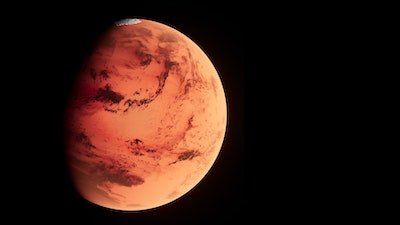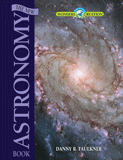
The Martian Runt
Mars is a runt because it formed quickly and was lucky enough to stay out of the way of on-coming traffic. So goes the latest step in the planetary shuffle.
News Source
- Science: “Why Mars Is a Planetary Runt”
Radiometric dating of Martian meteorites has always produced inconsistent results. The latest dating surprises have prompted creative additions to the nebular hypothesis. This theory about the origin of the solar system suffers from many inconsistencies. Among its problems, it fails to explain the disproportionately small size of Mars compared to Earth and Venus. The latest radiometric dating modifications are being used to explain why Mars is a runt.
Thousands of meteorites have been found over the years. Cosmochemists believe that around a hundred of these are from Mars because their chemistry matches the chemicals found in the Martian dirt and atmosphere. These rocks were presumably ejected from Mars as a result of asteroid collisions.
Scientists analyze Martian rocks with radiometric dating just as they do earth rocks. To explain their bizarre results, many have noted that extreme heat, exposure to acid,1 and impact heating (shock)2 can alter the actual decay rate or the decay rate calculations.3 The hafnium-182/tungsten-182 decay clock is one of the methods producing cryptic data. Therefore, planetary geochemists Nicholas Dauphas and Ali Pourmand have tried to find another isotope clock in non-Martian meteorites and use it to calibrate the Martian system.
The problem with the hafnium-tungsten dating method is thought to be that the Martian mantle’s chemical composition got altered by intense heat before recrystallizing as crust. Pieces of crust then got knocked into space, and some later fell to Earth as meteorites. In order to draw conclusions about the composition and age of Mars’s mantle from these meteorites, the researchers needed to find a way to recalibrate their clock so that they could trust its ability to “look back in time.” Dauphas and Pourmand found that hafnium-176/hafnium-177 decay mirrors that of the hafnium-tungsten system, but the hafnium system ratios do not get altered by heat. Therefore, they used their data to re-analyze the data obtained with hafnium-tungsten clocks. “They found that it took just 2 million to 4 million years to form Mars.”
The nebular hypothesis asserts that the solar system formed as dust orbiting the newborn sun stuck together to make tiny planets. Continuing to collide, some came together while others shattered. Scientists modeling this planetary dance have been unable to explain why Mars didn’t get bigger. Now they believe it grew for two to four million years and then stopped having collisions. Planetary dynamicist David Minton suggests that Jupiter wandered in close, pushed debris in Mars’s orbital path out of the way, and then moved back out with Saturn. “It seems crazy,” Minton says, but “there are all these ways of moving planets around early in the solar system’s history.”
This chaotic, anything-can-happen-in-a-collision scenario gets even more fanciful when planets must drift in and out of their orbits to make a way for little Mars to avoid any collisions that could make it grow but still allow the ones that knocked off the meteorites we’re finding on earth.
One of the problems with the nebular hypothesis is the notion that colliding star dust would stick together rather than bouncing off or exploding on impact like the debris in Saturn’s rings. Instead, the story goes that planets grew by glomming onto the planetary embryos they bumped into, except of course when they disintegrated. This chaotic, anything-can-happen-in-a-collision scenario gets even more fanciful when planets must drift in and out of their orbits to make a way for little Mars to avoid any collisions that could make it grow but still allow the ones that knocked off the meteorites we’re finding on earth.
The creative nature of planetary dynamics is now augmented as the isotopic clock recalibration is gladly accepted into the solar system fairy tale. However, other recalibrations should be considered. Research has shown that the half-life of lutetium-176 is dramatically altered by extreme heat, changing from 41 billion years to just 8 days. If uniformitarian assumptions can fail dramatically in the face of heat, acid, and impact, might it not be wise to consider that none of these dates from meteorite dating are trustworthy? Instead, consider that God plainly told us the truth: on the fourth day He shaped matter into the sun, moon, and stars.
Further Reading
- Get Answers: Astronomy, Radiometric Dating
For More Information: Get Answers
Remember, if you see a news story that might merit some attention, let us know about it! (Note: if the story originates from the Associated Press, FOX News, MSNBC, the New York Times, or another major national media outlet, we will most likely have already heard about it.) And thanks to all of our readers who have submitted great news tips to us. If you didn’t catch all the latest News to Know, why not take a look to see what you’ve missed?
(Please note that links will take you directly to the source. Answers in Genesis is not responsible for content on the websites to which we refer. For more information, please see our Privacy Policy.)
Footnotes
- Lewis Brindley, “Mars Meteorite Gets a Boost of Youth,” Royal Society of Chemistry, April 15, 2010, https://www.chemistryworld.com/news/mars-meteorite-gets-a-boost-of-youth/3002421.article.
- Ibid. See also G. Jeffrey Taylor, “A Younger Age for the Oldest Martian Meteorite,” Planetary Science Research Discoveries, May 12, 2010, http://www.psrd.hawaii.edu/May10/YoungerALH84001.html.
- Note: Woodmorape’s article (ref. 6) cites actual decay rate alteration due to extreme heat. The other reference articles (ref. 8 added June 24, 2011) refer to alterations in the ratios of the elements involved by means other than decay (recrystallization, impact heating, chemical reactions) thereby making the calculations inconsistent and uninterpretable. As stated in this article, the problem with the hafnium-tungsten system was thought to be in the latter group.
Recommended Resources

Answers in Genesis is an apologetics ministry, dedicated to helping Christians defend their faith and proclaim the good news of Jesus Christ.
- Customer Service 800.778.3390
- Available Monday–Friday | 9 AM–5 PM ET
- © 2025 Answers in Genesis





